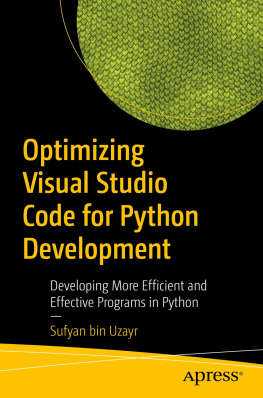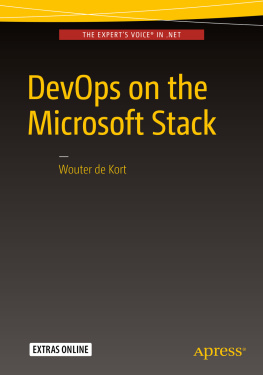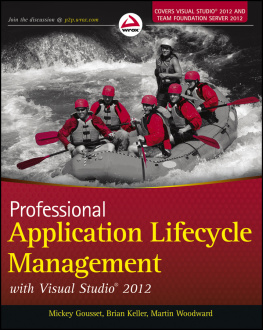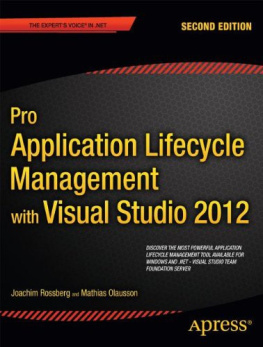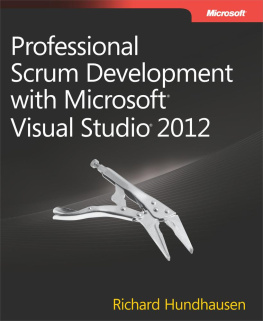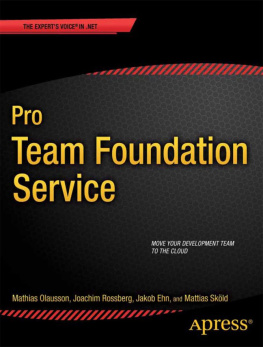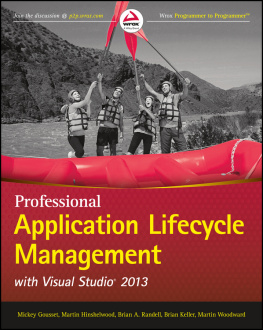Praise for Agile Software Engineering with Visual Studio
Agile dominates projects increasingly from IT to product and business development, and Sam Guckenheimer and Neno Loje provide pragmatic context for users seeking clarity and specifics with this book. Their knowledge of past history and current practice, combined with acuity and details about Visual Studios agile capabilities, enable a precise path to execution. Yet their voice and advice remain non-dogmatic and wise. Their examples are clear and relevant, enabling a valuable perspective to those seeking a broad and deep historical background along with a definitive understanding of the way in which Visual Studio can incorporate agile approaches.
Melinda Ballou, Program Director, Application Lifecycle Management and Executive
Strategies Service, International Data Corporation (IDC)
Sam Guckenheimer and Neno Loje have forgotten more about software development processes than most development gurus ever knew, and thats a good thing! In Agile Software Engineering with Visual Studio, Sam and Neno distill the essence of years of hard-won experience and hundreds of pages of process theory into what really mattersthe techniques that high performance software teams use to get stuff done. By combining these critical techniques with examples of how they work in Visual Studio, they created a de-facto user guide that no Visual Studio developer should be without.
Jeffrey Hammond, Principal Analyst, Forrester Research
If you employ Microsofts Team Foundation Server and are considering Agile projects, this text will give you a sound foundation of the principles behind its agile template and the choices you will need to make. The insights from Microsofts own experience in adopting agile help illustrate challenges with scale and the issues beyond pure functionality that a team needs to deal with. This book pulls together into one location a wide set of knowledge and practices to create a solid foundation to guide the decisions and effective transition, and will be a valuable addition to any team managers bookshelf.
Thomas Murphy, Research Director, Gartner
This book presents software practices you should want to implement on your team and the tools available to do so. It paints a picture of how first class teams can work, and in my opinion, is a must read for anyone involved in software development. It will be mandatory reading for all our consultants.
Claude Remillard, President, InCycle
This book is the perfect tool for teams and organizations implementing agile practices using Microsofts Application Lifecycle Management platform. It proves disciplined engineering and agility are not at odds; each needs the other to be truly effective.
David Starr, Scrum.org
Sam Guckenheimer and Neno Loje have written a very practical book on how Agile teams can optimize their practices with Visual Studio. It describes not only how Agile and Visual Studio work, but also the motivation and context for many of the functions provided in the platform. If you are using Agile and Visual Studio, this book should be a required read for everyone on the team. If you are not using Agile or Visual Studio, then reading this book will describe a place that perhaps you want to get to with your process and tools.
Dave West, Analyst, Forrester Research
Sam Guckenheimer and Neno Loje are leading authorities on agile methods and Visual Studio. The book you are holding in your hand is the authoritative way to bring these two technologies together. If you are a Visual Studio user doing agile, this book is a must read.
Dr. James A. Whittaker, Software Engineering Director, Google
Agile development practices are a core part of modern software development. Drawing from our own lessons in adopting agile practices at Microsoft, Sam Guckenheimer and Neno Loje not only outline the benefits, but also deliver a hands-on, practical guide to implementing those practices in teams of any size. This book will help your team get up and running in no time!
Jason Zander, Corporate Vice President, Microsoft Corporation
Agile Software Engineering with Visual Studio
From Concept to Continuous Feedback
Sam Guckenheimer
Neno Loje

Upper Saddle River, NJ Boston Indianapolis San Francisco
New York Toronto Montreal London Munich Paris Madrid
Cape Town Sydney Tokyo Singapore Mexico City
Many of the designations used by manufacturers and sellers to distinguish their products are claimed as trademarks. Where those designations appear in this book, and the publisher was aware of a trademark claim, the designations have been printed with initial capital letters or in all capitals.
The authors and publisher have taken care in the preparation of this book, but make no expressed or implied warranty of any kind and assume no responsibility for errors or omissions. No liability is assumed for incidental or consequential damages in connection with or arising out of the use of the information or programs contained herein.
The publisher offers excellent discounts on this book when ordered in quantity for bulk purchases or special sales, which may include electronic versions and/or custom covers and content particular to your business, training goals, marketing focus, and branding interests. For more information, please contact:
U.S. Corporate and Government Sales
(800) 382-3419
For sales outside the United States, please contact:
International Sales
Visit us on the Web: informit.com/aw
The Library of Congress cataloging-in-publication data is on file.
Copyright 2012 Pearson Education, Inc.
All rights reserved. Printed in the United States of America. This publication is protected by copyright, and permission must be obtained from the publisher prior to any prohibited reproduction, storage in a retrieval system, or transmission in any form or by any means, electronic, mechanical, photocopying, recording, or likewise. For information regarding permissions, write to:
Pearson Education, Inc.
Rights and Contracts Department
501 Boylston Street, Suite 900
Boston, MA 02116
Fax (617) 671-3447
The .NET logo is either a registered trademark or trademark of Microsoft Corporation in the United States and/or other countries and is used under license from Microsoft.
Microsoft, Windows, Visual Studio, Team Foundation Server, Visual Basic, Visual C#, and Visual C++ are either registered trademarks or trademarks of Microsoft Corporation in the U.S.A. and/or other countries/regions.
ISBN-13: 978-0-321-68585-8
ISBN-10: 0-321-68585-7
Text printed in the United States on recycled paper at R.R. Donnelly in Crawfordsville, Indiana.
First printing September 2011
To Monica, Zoe, Grace, Eli, and Nick, whose support made this book possible.
Sam
Foreword
It is my honor to write a foreword for Sams book, Agile Software Engineering with Visual Studio. Sam is both a practitioner of software development and a scholar. I have worked with Sam for the past three years to merge Scrum with modern engineering practices and an excellent toolset, Microsofts VS 2010. We are both indebted to Aaron Bjork of Microsoft, who developed the Scrum template that instantiates Scrum in VS 2010 through the Scrum template.
I do not want Scrum to be prescriptive. I left many holes, such as what is the syntax and organization of the product backlog, the engineering practices that turned product backlog items into a potentially shippable increment, and the magic that would create self-organizing teams. In his book, Sam has superbly described one way of filling in these holes. He describes the techniques and tooling, as well as the rationale of the approach that he prescribes. He does this in detail, with scope and humor. Since I have worked with Microsoft since 2004 and Sam since 2009 on these practices and tooling, I am delighted. Our first launch was a course, the Professional Scrum Developer .NET course, that taught developers how to use solid increments using modern engineering practices on VS 2010 (working in self-organizing, cross-functional teams). Sams book is the bible to this course and more, laying it all out in detail and philosophy. If you are on a Scrum team building software with .NET technologies, this is the book for you. If you are using Java, this book is compelling enough to read anyway, and may be worth switching to .NET.


